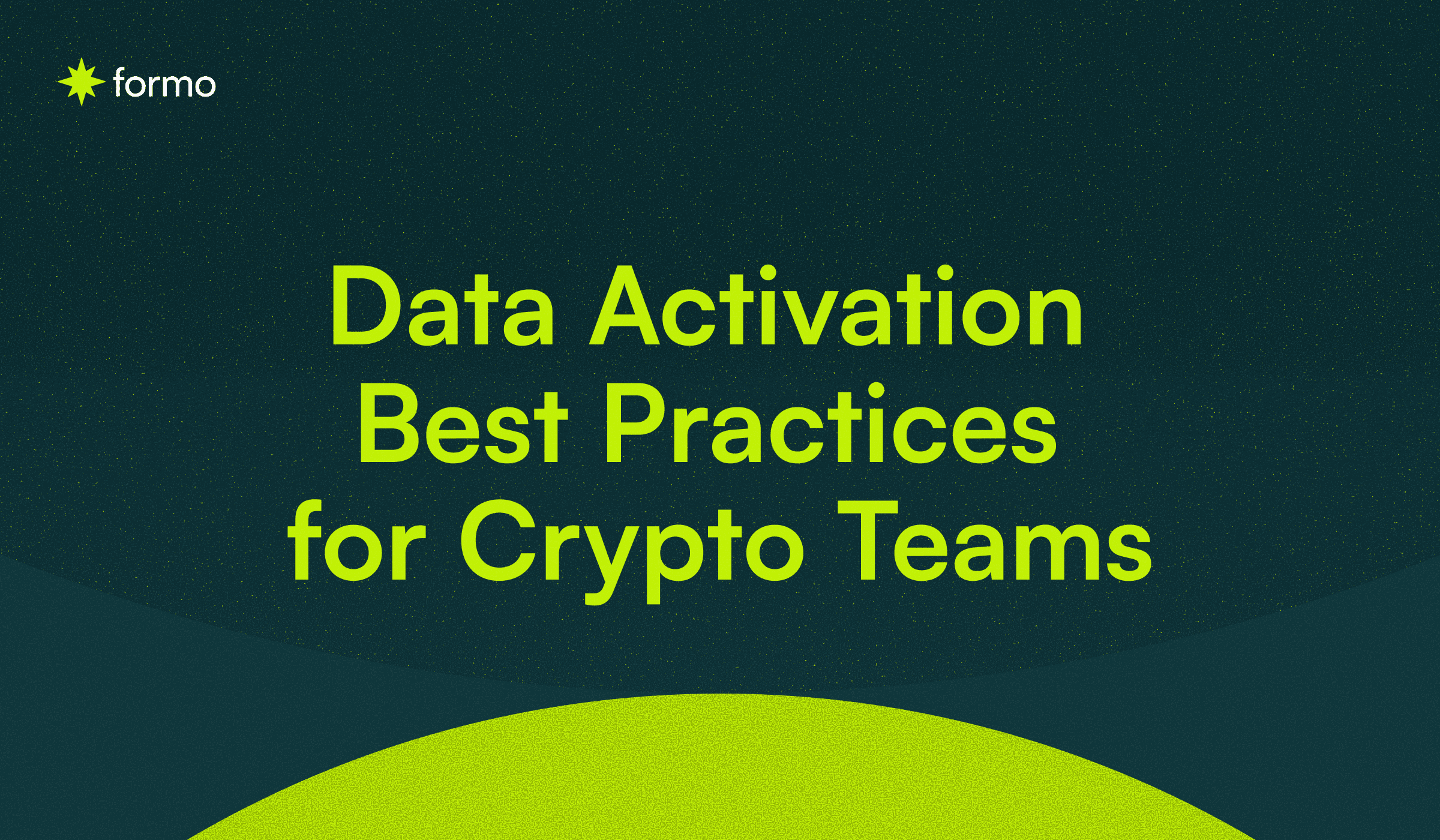Web2 and Web3 refer to different “phases” of the internet with very different characteristics, which lead to changes in terms of operation and marketing. With the introduction of blockchains, wallets, and tokens, marketing in the Web3 space requires teams to adapt to a different landscape.
This article explores the key differences between marketing in Web3 and Web2 and give you a guide on how to accelerate onchain growth.
Key Takeaways
Web3 has some notable differences compared to Web2, including identity, data ownership, and marketing channels.
Key strategies include content marketing, Search Engine optimization, and Generative Engine Optimization, quests, and partnerships.
Web2 vs Web3 Marketing
Web2 and Web3 Marketing are different.
Web2 marketing focuses on brand-to-user interactions. Companies use websites, SEO, social media, and email campaigns to reach customers, with growth driven mainly by broadcasting messages rather than user participation.
Web3 marketing utilizes many Web2 techniques as well, but focuses on pseudonymous users who interact through crypto wallets. It emphasizes community-building, user engagement, and two-way interactions, often leveraging token incentives and decentralized platforms to foster direct relationships with users.
Key Differences Between Web2 and Web3 Marketing
Identity
In Web2, users are identified through emails, usernames, and login accounts, which link their activity across platforms to personal profiles. In Web3, users often interact pseudonymously via crypto wallet addresses, prioritizing privacy and giving users more control over their digital identity.
Data
Web2 platforms rely on proprietary data collected by companies, often limited to user behavior within their ecosystem. Web3 leverages on-chain data, which is publicly available and provides rich insights into user activity, token holdings, and transaction behavior that can inform marketing and product strategies in ways not possible in Web2.
Channels
Web2 marketing relies on traditional channels such as Google Ads, Facebook Ads, SEO, email campaigns, and YouTube. Web3 adds new channels, including quests and missions, DAO proposals and collaborations, referral programs, token incentives, and community-driven campaigns. These channels focus on actively engaging users and rewarding participation.
Interoperability
Web2 systems are mostly siloed, requiring users to maintain separate accounts across different platforms. Web3 emphasizes interoperability: decentralized systems allow users to maintain a unified identity across multiple apps and protocols. This reduces switching costs, encourages cross-platform engagement, and increases competition in the ecosystem.
Web3 Marketing Strategies
Here are 8 Web3 marketing strategies you can utilize:
Community Building
Community building is a key Web3 marketing strategy in this context, through fostering conversation and relationships between Web3 enthusiasts. Leveraging these communities can help brands grow and increase visibility organically through referrals.
Here’s how you effectively build a community:
Identify relevant channels: Identify key Web3 platforms where your target audience is most active and utilize them.
Active participation and building trust: Engage actively with community members through discussions and educational content to build trust.
Encourage feedback: Ask for feedback and conduct surveys with your community.
Search Engine Optimization (SEO) and Generative Engine Optimization (GEO)
Search Engine Optimization (SEO) is crucial for organic growth. Optimizing your website to rank higher on search engines helps drive organic traffic and increase visibility. Nowadays, with AI adoption, optimizing your sites so that they show up on generative AI answers is equally important.
Here are some strategies you can use for both SEO and GEO:
Understand your audience: What they need, what kind of content would trigger them to click and explore more. Conduct keyword research to discover product messaging terms that resonate with your ideal customer profile (ICP).
Keyword research: Identify keywords relevant to your user search intent and use them in your blog posts for visibility.
Webpage optimization: Page structure is extremely important; optimize titles, descriptions, and headings so that search engines can effectively “crawl” your pages for answers.
Create high-quality content: Create high-quality, educational content relevant to your brands and use targeted keywords consistently throughout.
Storytelling: The very core of any content. Use case studies, testimonials, and experts’ opinions to build thought leadership and interest in what you’re offering, and keep the audience engaged.
Social Media Marketing
Social media remains a powerful tool for Web3 marketing, it helps brands build an online presence and connect with users. Web3 users are on X, Discord, and Reddit, so your marketing efforts should be on these platforms.
For your social media strategy, you can consider the following:
Create useful content: A good mix of educational and entertaining content related to Web3, DeFi, and tokens can help build an audience. Your content should vary in terms of format (infographics, videos, etc.).
Collaborations: Partner with Web3 influencers, brands, podcasts, Q&As, and webinars to widen your reach.
KOL / Influencer Marketing
Influencer (KOL) marketing is a powerful way to build trust and visibility in Web3. Instead of chasing follower counts, focus on community engagement, on-chain activity, and authenticity.
How to Run Effective KOL Campaigns:
Pick the right influencers: Look for Web3-native voices active on X (Twitter), Discord, or Telegram.
Match influencer tier to goals: Choose influencers with numbers of followers that match your goals, such as mega Influencers for awareness, mid-tier influencers for community growth, and micro-influencers for conversions and loyalty.
Align with values: Choose influencers who reflect your project’s vision and keep partnerships transparent.
Use diverse formats: Twitter threads, AMAs, YouTube explainers, and podcasts build reach and credibility.
Track results: Measure impact with UTM links, referral codes, and on-chain metrics like wallet sign-ups or transactions.
Quests / Bounties
Bounty campaigns reward stakeholders for completing certain actions, e.g., promoting on
Quests and bounty campaigns are a core growth strategy in Web3. They reward users for completing specific actions such as promoting on social media, creating educational content, testing products, or reporting bugs. Unlike traditional ads, they activate communities through engagement and participation.
Here is how you can run effective bounty campaigns:
Set clear goals: Decide whether your campaign is for awareness, product testing, user acquisition, or community growth.
Define actions & rewards: What actions do you want your users to take, e.g., tweet about the project, stake tokens, join a Discord, or write a blog post.
Choose the right platform: Use quest platforms like Galxe, Zealy, or Boost.xyz for on-chain tracking and transparent reward distribution.
Keep communication clear: Publish campaign rules, deadlines, and reward structures upfront to build trust.
Measure & optimize: Track KPIs like wallet sign-ups, mints, or DAO participation to refine future quests.
For example, Turtle Club launched "The Summoning" campaign to incentivize liquidity provision for Renzo’s ezETH token. Participants deposit ezETH via their wallets and earn boosted rewards—25% in Turtle Boosts and 1.75× TAC rewards. The campaign also features fair, fixed token allocations (280M $TAC and 20M $TURTLE), with no inflation or lockups, and real-time campaign data visible to users. This provides a transparent, on-chain bounty-like model tailored for DeFi liquidity growth.
Email Marketing
Email marketing is simple yet effective as it allows Web3 brands to directly communicate with their audience and build a loyal customer base.
Here’s how to do email marketing:
Curate mailing list: Collect contacts from qualified leads — users who have shown genuine interest, and then segment them.
Bring them value with your email: Educational content, early access, exclusive content, etc. Your email needs to bring them value to encourage them to convert.
Sponsoring newsletters: Some newsletters already have an established audience, such as Week in Ethereum News, so you can sponsor them to reach more onchain users.
Cross-post your newsletters to content-publishing platforms: Emails can only reach audiences that subscribe to your newsletter. So, you can extend your reach by posting it on other platforms like Substack to reach more people.
Partnerships
Partnerships are one of the strongest growth levers in DeFi, enabling you to tap into new liquidity, strengthen community trust, and accelerate adoption.
How to build effective partnerships in Web3 and DeFi:
Liquidity sharing: Launch joint liquidity pools (e.g., SushiSwap x Yearn vaults, Curve x Convex) to strengthen both protocols’ TVL and boost user rewards.
Cross-platform incentives: Run co-branded reward programs, such as staking one project’s token to earn a partner’s token (e.g., Aave lending markets rewarding Balancer LPs).
Composable products: Integrate features across protocols — for instance, lending markets that accept LP tokens as collateral, or vault strategies that layer multiple protocols (like Yearn leveraging Curve + Convex).
Co-marketing and community activations: Reach a bigger audience through cross-promotional activities, joint campaigns, or endorsements. Host joint governance proposals, AMAs, or quest campaigns that bring users from both sides together (e.g., Arbitrum ecosystem quests involving multiple DeFi apps).
Ecosystem integrations: Collaborate with wallets and bridges (e.g., MetaMask swaps, Lido x RocketPool staking integrations) to embed your protocol deeper into the DeFi stack.
Supercharge your Web3 marketing strategy with Formo
Web3 Marketing requires a fundamentally different approach than Web2 Marketing. If you’re looking to accelerate your onchain growth, Formo is your growth partner. Formo makes Web3 analytics easy and accessible for Web3 marketing teams. Get actionable insights you need to drive sustainable growth for your onchain app, with unified analytics and attribution.
Follow us on LinkedIn and Twitter, and join our community to learn more onchain growth insights!
Read more:
Mastering Web3 Marketing Attribution Analytics: A Complete Guide
The Beginner’s Guide to Data-Driven Web3 Marketing
10 Best Web3 Community Tools to boost engagement
FAQs
1. Why do web2 marketing tactics don’t always work in web3?
Marketing strategies that succeed in Web2 often fail in Web3 because the audience, identity, and technology are fundamentally different. In Web2, marketers rely on cookies, browsing history, and demographic data to drive campaigns. Web3 users, however, are pseudonymous and engage through digital wallets, DAOs, and decentralized platforms.
To succeed in Web3 marketing, you need to be data-driven. Focus on on-chain wallet activity, revenue tracking, and onchain attribution. Go beyond surface-level metrics like clicks and page views. Measure revenue and retention instead.
2. What are some key tactics to consider when doing marketing in Web3?
While core marketing principles like content creation, storytelling, and community building still apply, Web3 introduces a unique focus on incentivized engagement. Strategies like airdrops, token-gated experiences, rewards, and bounties can work well if designed and monitored carefully. Social platforms like X (Twitter), Discord, and Telegram are still core channels, but success depends on how well you build trust and deliver real utility to your audience.
Make every marketing dollar count. Use a web3 analytics tool that supports onchain attribution like Formo, so you can measure the ROI and performance of your web3 marketing efforts.
3. How can I build an online presence in the Web3 space?
Unlike Web2, where ads and influencer partnerships dominate, Web3 presence relies on organic, community-driven growth. To stand out:
Be community-driven: Spend time in Discord, Telegram, and DAO forums where your audience already gathers. Actively engage in conversations instead of just broadcasting updates.
Show transparency: Publish open roadmaps, share development progress, and keep your community updated through governance proposals or AMAs (Ask Me Anything sessions).
Leverage founder-led growth: In Web3, people follow people more than logos. Founders who are visible, approachable, and vocal on X, podcasts, or community calls build stronger connections. Founder-led storytelling creates credibility, drives word-of-mouth, and helps humanize the brand in a space where scams are common.
Collaborate with other projects: Cross-community partnerships, joint campaigns, or co-hosted Twitter Spaces can expand your reach and credibility.
Prioritize authenticity: Long-term success depends on showing up consistently and aligning your brand’s actions with your stated values.
Ultimately, authenticity, transparency, and long-term community trust are what builds strong brand equity in Web3.
4. What are Web3-native tools that can help shape a marketing strategy?
Web3 offers a growing ecosystem of tools designed for on-chain analytics, engagement, and loyalty tracking. Popular platforms include:
Formo – growth and data platform for onchain apps
Galxe – offer incentivized tasks and reward-based loyalty programs to boost user acquisition, attention, and distribution.
Addressable - attribution and ad inventory that enables targeting of active crypto wallets.
MetaCRM - a crypto-native segmentation platform that shows a 360 view of onchain audience.
Onchain growth tools allow you to track wallet behavior, design token-based loyalty programs, and understand how your users engage with your product on-chain.
5. Is Web3 marketing more expensive than Web2 marketing?
Not necessarily. Web3 campaigns may cost less in traditional ad spend since community engagement, airdrops, and organic reach play a bigger role. However, costs may shift toward reward systems and token incentives. Instead of paying an ad platform to acquire users, part of Customer Acquisition Cost (CAC) may go to the users themselves. Your ROI depends on how effectively you align rewards with long-term community growth instead of short-term hype.





